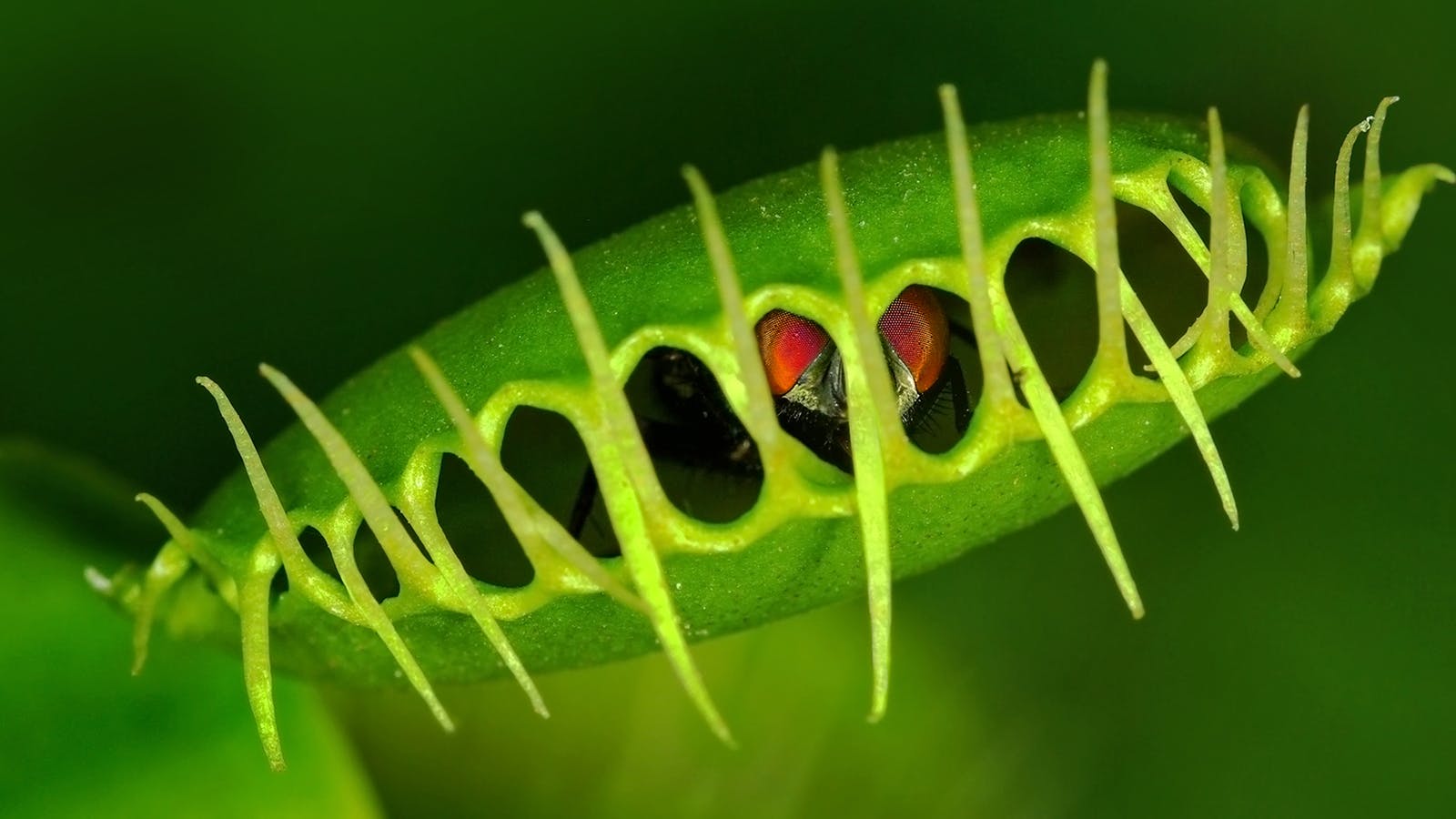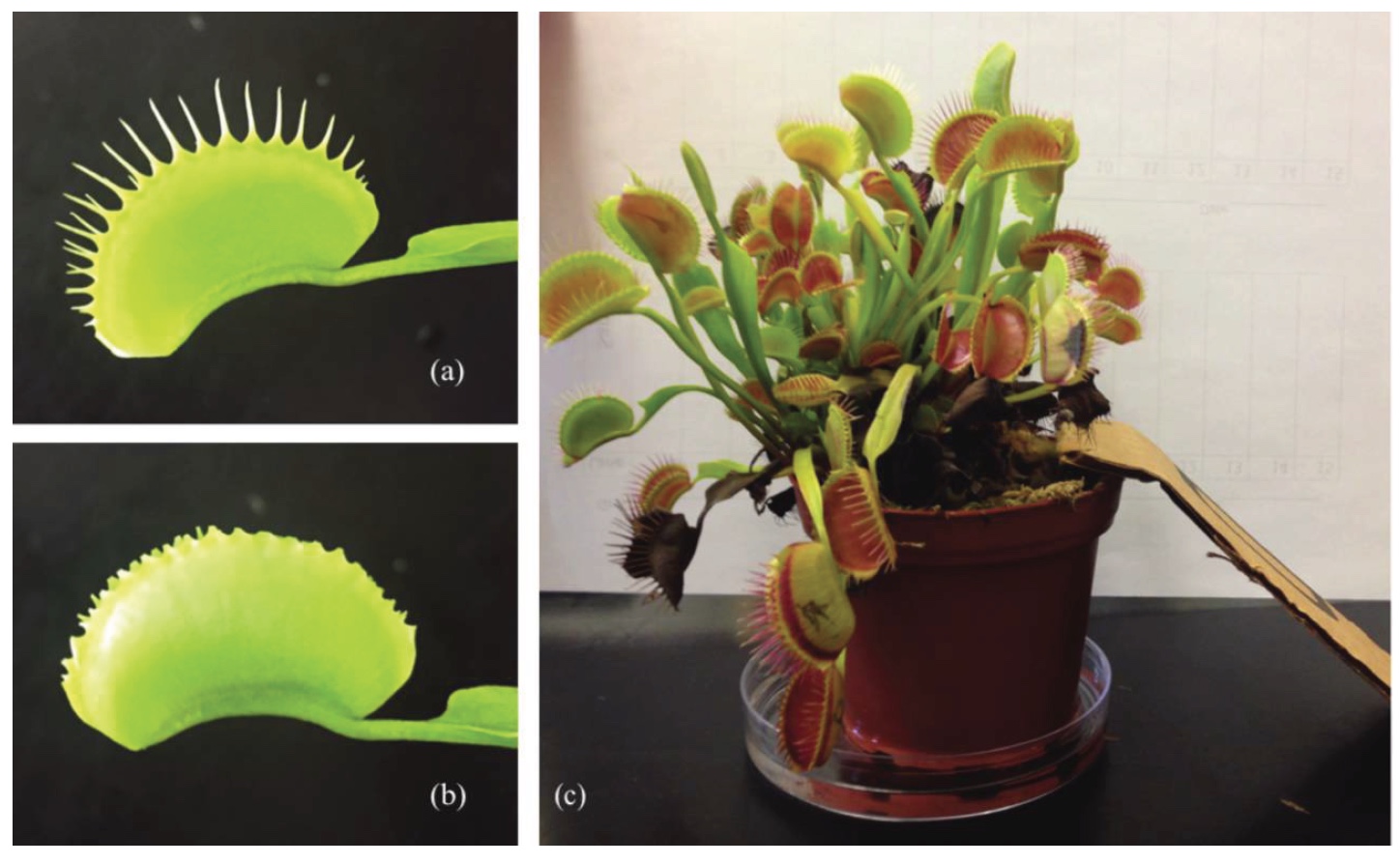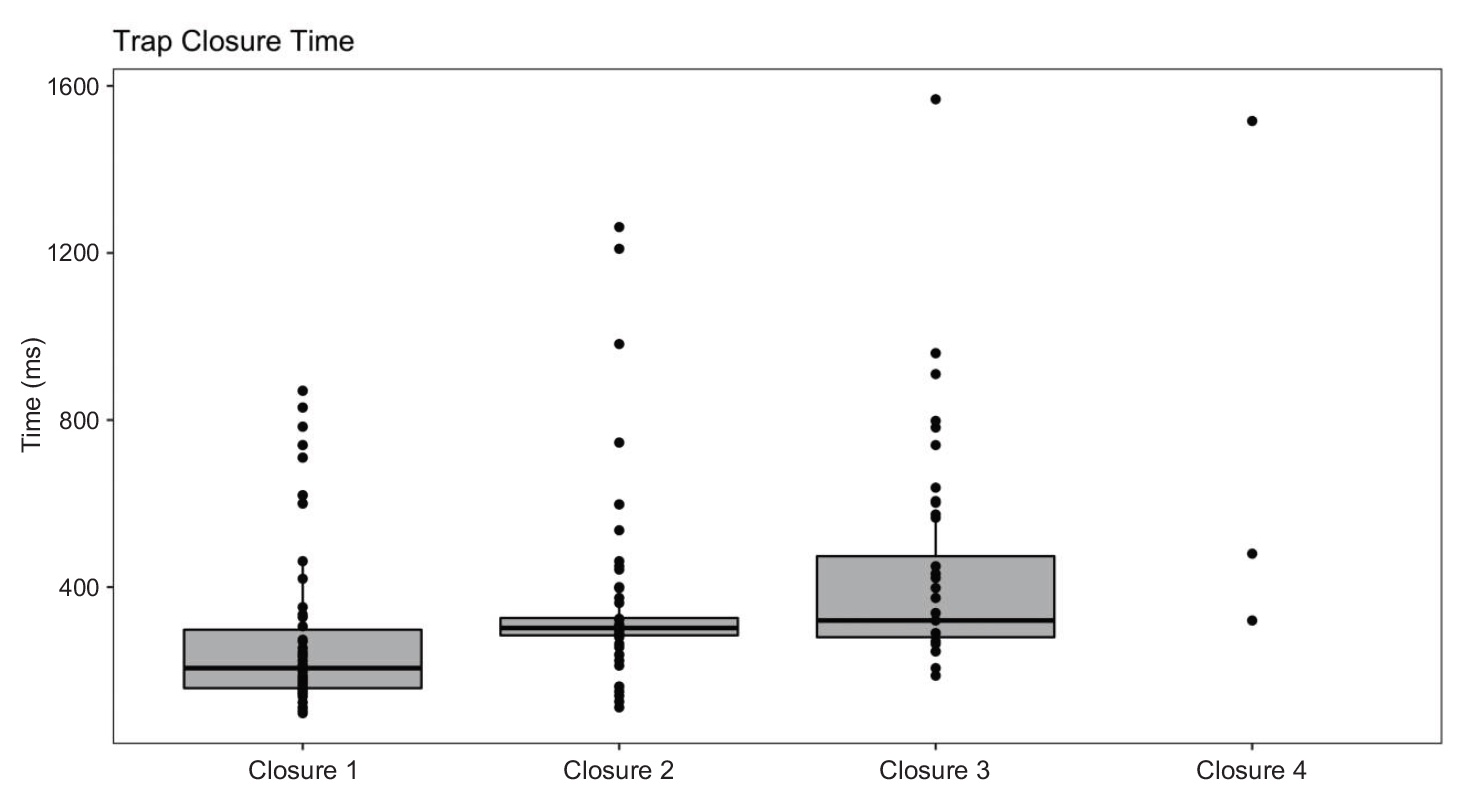Terrible prison: a study of the marginal thorns of Venus flytrap

Friday is a wonderful day when gray days come to an end (forgive me for pouring salt on the wound on those who work on Saturday / Sunday), long-awaited weekends await, and we have time to do something pleasant and interesting: read a book which has already collected a record layer of dust; visit relatives if they still remember you; sleep well, waking up in the morning, not from a terrible alarm clock, but naturally; water the flower in a pot, which soon evolves into a cactus, tumbleweed or a carnivorous monster, as in the movie “Little Shop of Horrors”. In this film, the killer plant is a fictional creature, but it has a progenitor in the real world - predatory plants, more specifically, the Venus flytrap. This plant is Jason Voorhees in the world of insects. And as for Jason, the machete is characteristic, so the flycatcher is characterized by its marginal (marginal) spikes. Today we will get acquainted with the study, in which scientists decided to check how important these spikes are in catching prey. Naturally, they are important - you will say that you are right, but the results of the research were not without surprises. Let's not pull the mosquito by the proboscis and dive into the report for an explanation. Go.
"A terrible prison"
We all know the concept of photosynthesis, which refers to the chemical process of converting light energy into the energy of chemical compounds. However, not all plants like the solar diet, more precisely, not everyone can feed themselves exclusively in this way due to certain climatic conditions and place of growth. If you want to live - know how to spin, in this case, evolve into the nightmare of all the flies. In other words, predatory plants, in addition to the “classic” diet, receive the necessary substances (for example, nitrogen) by digesting insects (or other creatures that are not very lucky). In total, there are about 630 species of carnivorous plants that grow in almost all regions of the planet and differ in both the method of hunting and gastronomic preferences.
')
By type of catching prey of predatory plants can be divided into two main types: active and passive. The first have moving parts (like our today's heroine flytrap), and the second - sticky secretions on the surface of the leaves or containers where the victim dumps herself.

Biblis giant
The largest representatives of predatory plants are biblis giant and nepentes. Biblis giant resembles an ordinary shrub with very beautiful flowers, but this plant is very insidious - all its leaves and stems are covered with small hairs (about 300,000 pieces on 1 sheet) and glands that secrete juice. This nectar attracts the sacrifice, which, having cocked on free food, becomes the very food itself, sticking tightly to the hairs. At the same time, the juice secreted by the plant is not just a bait, but also a digestion tool. The victims of the bible can be both insects and snails, and small amphibians or very unsuccessfully landed birds.
The symbiotic relationship between the nepentes and the spider, using the plant reservoir as a place for "fishing."
The second name of nepentes is a pitcher that directly speaks about the method of catching prey. Nepentes has two kinds of leaves: ordinary and unusual, which form a jug hanging in the air, filled with nectar. The edges of this pitcher are also covered with nectar, because the insect attracted by its smell sits down and rolls inside, where it is digested by the plant. But Nepentes is different from other plants of predators, it is not only a serial killer, but also a good friend if you are stupid. This little animal feeds on the nectar of the plant and uses its pitcher-trap like a chamber pot. The waste products are digested and give the plant the necessary nutrients.

Even in the flowering of the flycatcher, there is logic: flowers bloom on a long stem, far from traps, in order to protect pollinating insects from an accident at work.
And, finally, active predators. The most famous among them is the flycatcher. Its leaves at the end of a thin stalk resemble a trap or an open, hungry, and very toothed maw. Inside the trap is covered with thin and very sensitive hairs, hitting which the victim activates the slamming of the trap. But this method of activation is not the most effective, you think. And if the wind blew or it started to rain, and the hair was touched by chance? But do not worry, for the mechanism of this flycatcher has improved many years of evolution. To close the sash, you need to hit at least 2 hairs with an interval of not more than 20 seconds. In this case, the process of digestion, which takes place inside the trap, will begin only after re-stimulation of sensitive hairs. Thus, the flycatcher will not begin the process of digesting, for example, a fallen leaf, thereby saving energy for real prey.
The mechanism for slamming a trap in flycatchers is based on chemical and cellular processes. The most important role is played by tissue turgor, that is, the stress state of the membranes of living cells. When the victim stimulates sensitive hairs, an action potential is generated by potassium ions, which spreads through the leaf lobes and stimulates the cells. When the trap is open, its lobes are bent outward (so it will be easier for the victim to fall into the trap), and when the trap is closed, the lobes are bent in the opposite direction. Thus, the inner space is formed. The living sacrifice will not stand still, but will constantly move, trying to get out. But here, as in a swamp - the more you move, the faster you will drown. Constant movements of the victim stimulate the hairs, which leads to the release of the digestive enzyme. If the prey turned out to be smarter and faster and was able to escape, then the trap closed in vain will open only in 2-3 days.
An important aspect of the work of traps is their fragility and deformation. Slapping the leaf fractions in the idle leads to the fact that in subsequent times the trap will close more slowly, and the angle of the open state will be much smaller. As you and I understand, such changes can greatly affect the capture of prey, and therefore lead to the death of the plant due to starvation. In addition, after several closure traps die off quite quickly.
True Facts: Carnivorous Plants (True Facts: Carnivorous Plants). Clip contains a lot of black humor and a bit obscene language.
Edge spikes, which prevent the victim from escaping from the stomach-trap, play an important role in catching prey for flytraps. However, as with sensitive hairs, so with these thorns is not so simple.
The study, which will be discussed, is based on the hypotheses of Charles Darwin, who first described the mechanism of hunting for the Venus flytrap, calling it a trap "a terrible prison." He suggested that the thorns are important not only to keep the prey, but also as a kind of method of its “filtration”. In other words, too small a prey, the nutritional benefits of which will not be enough, will be able to get between the spikes, and too large a prey will simply reveal the leaf and also run away. Both in the first and in the second case, the energy costs of the flycatcher for such types of prey would be incomparable with the resulting energy from their digestion. Accordingly, the flycatcher spikes allow it to catch prey of a certain size. However, despite the fact that more than 100 years have passed since the discoveries of Darwin, no one has tested his hypotheses in practice. That is what the scientists decided to do in their research.
Such attention from scientists Venus flytrap did not know. Researchers measured extraction efficiency, trap closure time and the effect of edge spikes in the wild as well as in the laboratory. Also, scientists checked the efficiency of the thornless trap, after removing them.
Research results
Plant observations were conducted in the wild (Green swamps in North Carolina, USA), in laboratory and in hybrid conditions. Green marshes are one of the few areas where endemic species of flycatchers can still be found. Scientists have identified 14 individual plants, whose traps they have divided into 4 categories: live and closed, dead and closed, live and open, dead and open. A total of 100 traps were counted. With the help of x-raying, the presence of something (prey or debris) inside closed traps was established: traps with something denoted “1”, empty traps - “0”.
Among the closed traps of wild flycatchers, only 24% contained prey. It was precisely possible to establish that in 8 out of 98 traps there was rubbish, and 2 definitely contained insects (an ant in one and a spider in the second). 55 ± 5% of the traps were open and capable of catching prey (live, intact leaves). The percentage of closed traps with prey inside varied from 0 to 50% depending on the individual plant in question. In 5 plants, this indicator was 0%, in another five - from 0 to 33%, and in another four - 34-50%.
In the laboratory experiment, cultivated plants and purchased crickets took part, which in the wild take about 10% of the flycatcher's diet. All the insects involved in the tests were healthy, with all six paws in place. Their length varied from 7 to 23 mm, and weight - from 0.026 to 0.420 grams. In the laboratory test, all traps were labeled the same as in the observations in the wild: closed, but empty - “0”, closed and with prey inside - “1”. Check traps took place after 3 days and 1 week after the start of the test.

Image №1: a - a trap with edge spikes, b - a trap without thorns, c - a laboratory experiment (1 plant in a container with water, 1 cricket and a ladder, so that it is easier for the insect to reach the plant).
After the first approach, the scientists removed the edge spikes from the closed traps ( 1b ). After this, the plant was given 1 week to restore and open the trap.
After the traps were re-opened (already without spikes), the second stage of testing was carried out using the new cricket. A total of 51 test visits were carried out with 34 plants: 17 plants — observations without manipulation by humans, and another 17 — observations before and after the removal of thorns. There were also two types of test visits: 5 with a dead cricket and 2 without an insect at all. Thus, it was possible to ascertain that the closure of traps occurs solely at the expense of living crickets, and not in a random order.
Among the traps of plants that have not been manipulated, only 16.5% successfully caught an insect. The traps that cut the spikes recovered after 4 days, but only 5.8% of them were able to catch prey. However, the procedure for removing thorns, that is, physical damage to plant tissues, did not have a negative effect. Thus, the closure rate, plant growth, and general condition did not differ in intact plants and plants with spikes removed. In addition, after only 1 week spikes began to grow again.
The likelihood of successful hunting with spikes removed has decreased by 90% compared to intact traps.

Image # 2: results of hunting for flycatchers in the wild (upper graph), in the laboratory (second and third graph), and in a hybrid experiment (lower graph).
However, these observations already indicate that with large mining volumes, the benefit from the presence of spikes is greatly reduced. A linear model with mixed effects showed that the weight of the prey is the determining factor in the success of the hunt. Thus, with an increase in the weight of an insect by only 0.1 g, the probability of successful capture is reduced by 73%.
Naturally, the dimensions of the traps themselves are also very important. With an increase in the length of the trap by 1 cm, the chance of a tasty meal for a plant increases by a factor of 2.9. It does not matter the presence or absence of marginal thorns.

Image number 3: the success of hunting intact plants (left) and plants with spikes removed (right). Z axis - probability of catching prey (color variation “blue-red” from the minimum to the maximum) depending on the weight of the prey (axis X) and the length of the trap (axis Y).
As we can see in the graph above, the probability of a successful capture from a trap without thorns (the graph on the right) is small enough when the production weight and trap length are also small. But with more weight and greater length, this figure is comparable to plants whose thorns remained in place.
The hybrid experiment was a change of location from the laboratory to the North Carolina Botanical Garden, where 22 flytraps were planted. On each plant there were 50/50 intact traps and thornless traps (the removal was performed in the laboratory before planting in the garden, after which the plant was restored and the traps opened). The observations lasted for 4 weeks, the scientists recorded all the data: the size of the caught prey or trash that fell in the trap, the size of the closed traps, the frequency of closing / opening, etc.
Plants in the botanical forest showed not very high results of successful capture of prey: 13.3% in untouched traps and 9.2% in traps without thorns. However, these results are very similar to those observed in controlled laboratories. In this case, as can be seen from the graph in image 2, the highest probability of success was observed precisely in the case of medium-sized mining.

Image number 4: the time required for the 1st, 2nd, 3rd and 4th closing of the trap.
Scientists also measured the speed of closing traps during the first, second and third visits. During the first closing, the speed was approximately 283 ± 29 ms, during the second - 383 ± 43 ms, and during the third - 528 ± 62 ms. Those few traps that survived to the fourth close showed a significant reduction in speed to 772 ± 374 ms. As we already know, fly trap traps cannot close / open infinitely many times. During the study, only 38 out of 50 traps survived after the second close, 25 out of 38 after the third, and only 4 traps survived until the end of the 4th week of the hybrid experiment.
For more detailed acquaintance with the study I recommend to look into the report of scientists .
Epilogue
Scientists note that the significance of marginal thorns on traps is not as great as it seemed before. Especially when it comes to large traps and / or large prey. Observations have shown that crickets very often climb on the spikes of the trap (not inside the trap). When the trap closes, a cricket can press down on the spikes and effortlessly get free. If there are no spikes on the big trap, then there is nothing to push, therefore the cricket remains in the trap. It turns out that thorns serve as an escape tool for large insects.
With small prey, everything is clear: if it provokes the closure of the trap, it will be selected through the openings between the spikes. Thus, the trap will open again, without spending energy on the digestion of low-nutrition food. In the case of large prey, it may seem that the flycatchers will only be happy to eat someone large and juicy. I caught a big tarantula and digest myself calmly, without thinking about finding food, so to speak. However, in practice, everything looks different - big booty uses thorns to get out. Scientists, in turn, will continue to study, in order to fully understand whether this is a disadvantage for flycatchers or whether it is still a well thought-out evolutionary mechanism for catching prey of certain sizes.
Whatever it was, this study allowed us to look at the life of predatory plants under the prism of mathematical measurements and calculations, and also to understand that not all evolutionary adaptations have an obvious purpose. The world of flora and fauna is full of secrets and mysteries that we still have to solve.
And, of course, Friday off-top:
A small movie from the movie “Little Shop of Horrors” (1986). In the role of Seymour, Rick Moranis, the voice of a carnivorous extraterrestrial plant - Levi Stubbs.
Thank you for your attention, stay curious and have a great weekend, guys.
A small movie from the movie “Little Shop of Horrors” (1986). In the role of Seymour, Rick Moranis, the voice of a carnivorous extraterrestrial plant - Levi Stubbs.
Thank you for your attention, stay curious and have a great weekend, guys.
Thank you for staying with us. Do you like our articles? Want to see more interesting materials? Support us by placing an order or recommending to friends, 30% discount for Habr's users on a unique analogue of the entry-level servers that we invented for you: The whole truth about VPS (KVM) E5-2650 v4 (6 Cores) 10GB DDR4 240GB SSD 1Gbps from $ 20 or how to share the server? (Options are available with RAID1 and RAID10, up to 24 cores and up to 40GB DDR4).
VPS (KVM) E5-2650 v4 (6 Cores) 10GB DDR4 240GB SSD 1Gbps before summer for free if you pay for a period of six months, you can order here .
Dell R730xd 2 times cheaper? Only we have 2 x Intel Dodeca-Core Xeon E5-2650v4 128GB DDR4 6x480GB SSD 1Gbps 100 TV from $ 249 in the Netherlands and the USA! Read about How to build an infrastructure building. class c using servers Dell R730xd E5-2650 v4 worth 9000 euros for a penny?
Source: https://habr.com/ru/post/445760/
All Articles